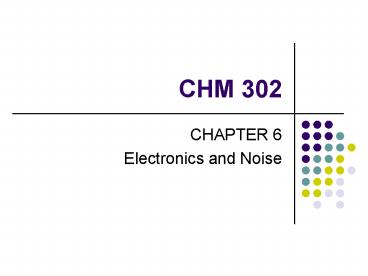CHM 302 PowerPoint PPT Presentation
1 / 25
Title: CHM 302
1
CHM 302
- CHAPTER 6
- Electronics and Noise
2
Overall process of an instrument measurement
3
- Some terms often used
- Detector refers to a mechanical, electrical
- or chemical device that identifies, records or
- indicates a change in one of the variables in
its - environment
- Transducer refers specifically to devices that
- convert information in non-electrical domains
- to information in electrical domains and vice
- versa
4
Current, Voltage and Resistance
- Measurements of these parameters are
- done through appropriate circuit
- - a closed pathway that may be followed by
- an electric current
- Convention current flows from more positive
- to more negative potential
- Current magnitude depends on the electric
- potential and the resistance to the flow
5
Ohms Law V IR for a series circuit
- Electrons may move spontaneously through a
- resistor or under the force of a voltage
6
Power
- The power P in watts in a resistive element
- is given by the product of the current (in
- amperes and the potential difference in volts
- P IV
- From Ohms Law
- P I2R V2/R
7
- Kirchhoffs Laws
- Two laws the current law and the voltage
- law
- Current law - the algebraic sum of currents
- around any point in a circuit is zero
- Voltage law is similar
8
- Two types of basic dc circuits
- - series resistive and parallel resistive
- circuits
9
- The previous series circuit is called a
- voltage divider
- In parallel circuits, resistors are placed with
end - connected to each other so they all have the same
- voltage across them
10
- A Wheatstone bridge allows the
- measurement of very small differences in
- voltage or resistance
11
Time-dependent circuit responses
- When current in an electrical circuit is
- increased or decreased energy is required to
- change the electric and magnetic field
- associated with the flow of charge
- An inductor resist the changes in the current
- - inductors are characterized by their
- inductance
12
- A capacitor resists changes in voltage
- - characterized by the capacitance
- A typical capacitor consists of a pair of
- conductors separated by a thin layer of a
- dielectric substance
- - a capacitor may be thought of as a time-
- dependent resistor that lowers its resistance
- as the frequency rises
13
Noise
- Every analytical measurement is made up
- of two components
- - the signal (carries information about the
- analyte)
- - noise made up of extraneous
- information that degrades accuracy and
- precision
- - also lower detection limits
14
- The term noise is used to describe the
- random fluctuations observed whenever
- replicate measurements are made on
- signals that are measured continuously
- In most measurements, the average strength of
- the noise is constant and independent of the
- signal
15
- For a typical dc signal
- - noise ? standard deviation of
- numerous measurements of signal
- strength
- - signal ? mean of the measurements
- Then
16
- Two types of noise
- - chemical and instrumental noise
- Chemical noise arise from uncontrollable
- variables that affect the chemistry of the system
- being analyzed
- - changes in light intensity that affect
- photosensitive materials
17
- Instrumental Noise
- Noise associated with each component
- of an instrument
- Certain kinds of instrumental noise are
- recognizable
- thermal or Johnson noise
- shot noise
- flicker or 1/f noise
- environmental noise
18
- Thermal noise
- - caused by the thermal agitation of
- electrons or other charge carriers
- - the agitation is random
- Thermal noise disappears only at absolute zero
19
- Shot Noise
- Shot noise is encountered whenever
- electrons or other charge particles crosses
- a junction
- Currents are composed of a series of quantized
- events
- - these events occur randomly and the rate
- at which they occur is subject to statistical
- fluctuations
20
Like thermal noise, shot noise is white
noise 1/f noise - characterized by having a
magnitude that is inversely proportional to the
frequency of the signal being measured
21
- Environmental noise
- This type is a composite of different forms
- of noise that arise from the surroundings
- So there are numerous sources
- - ac power lines, radio and TV stations, etc.
- Can be reduced by
- - shielding
- - grounding
- - minimizing conductor lengths
22
- The electrical signals generated from a
- stimulus of an analyte are usually quite
- small
- They are usually amplified
- Operational amplifiers are ubiquitous
- - they perform mathematical operations
- - allow for precise measurement of I, V, R
- Amplifiers have one or more inputs and an
- output connection
23
- A signal arriving at an input is increased by a
- certain amount before leaving the output
- When the output is a multiple of the input, the
- amplifier is a linear amplifier
24
- In fact the linearity of an instrument is
- directly dependent on the linearity of the
- amplifiers
- The amount of amplification is usually referred
- to as the gain
- Gain Poutput/Pinput
- Another important type of amplifier is the
- difference amplifier
25
- Noise appears in phase at both the
- inverting and non-inverting inputs
- - it is subtracted out by the circuit
- - so at the output noise is substantially
- reduced

